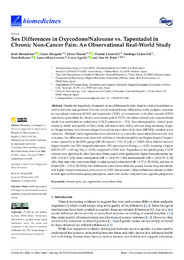Title:
Sex Differences in Oxycodone/Naloxone vs. Tapentadol in Chronic Non-Cancer Pain: An Observational Real-World Study |
Authors:
Barrachina, Jordi 
Margarit, Cesar
Muriel, Javier 
López Gil, Vicente 
López Gil, Santiago 
Ballester, Pura 
Mira-Lorente, Laura
Agulló, Laura 
Peiró, Ana  |
Editor:
MDPI |
Department:
Departamentos de la UMH::Farmacología, Pediatría y Química Orgánica |
Issue Date:
2022-10-02 |
URI:
https://hdl.handle.net/11000/32343 |
Abstract:
Despite the large body of research on sex differences in pain, there is a lack of translation to real-world pain management. Our aim was to analyse the sex differences in the analgesic response to oxycodone/naloxone (OXN) and tapentadol (TAP), in comparison with other opioids (OPO) commonly prescribed for chronic non-cancer pain (CNCP). An observational and cross-sectional study was conducted on ambulatory CNCP patients (n = 571). Sociodemographic, clinical (pain intensity, relief, and quality of life), safety (adverse events (AEs), adverse drug reactions), hospital frequentations and pharmacological (morphine equivalent daily dose (MEDD)) variables were collected. Multiple linear regressions were carried out to assess the association between sex and outcomes. Sex differences were observed, with lower female tolerability and higher hospital frequentation,
especially in the OXN group (OR AEs report = 2.8 [1.8–4.4], p < 0.001). Here, females showed higher hospital use (23% hospital admission, 30% prescription change, p < 0.05), requiring a higher MEDD (127 103 mg/day, p < 0.05), compared to OXN men. Regardless of the opioid group, CNCP women were significantly older than men (three years), with significantly higher benzodiazepine use (OR = 1.6 [1.1–2.3]), more constipation (OR = 1.34 [0.93–1.90]) and headache (OR = 1.45 [0.99–2.13]) AEs, than men who were more likely to refer sexual dysfunction (OR = 2.77 [1.53–5.01]), and loss of libido (OR = 1.93 [1.22–3.04]). Sex-differences were found related to poorer female drug tolerability and higher hospital resources, even worst in OXN female users. Other differences related to older female ages and benzodiazepine prescription, need to be further analysed from a gender perspective
|
Keywords/Subjects:
chronic pain
sex
tapentadol
oxycodone
bias |
Knowledge area:
CDU: Ciencias aplicadas: Medicina: Farmacología. Terapéutica. Toxicología. Radiología |
Type of document:
info:eu-repo/semantics/article |
Access rights:
info:eu-repo/semantics/openAccess |
DOI:
https://doi.org/10.3390/biomedicines10102468 |
Published in:
Biomedicines. 2022 Oct 2;10(10):2468 |
Appears in Collections:
Artículos Farmacología, Pediatría y Química Orgánica
|

.png)
